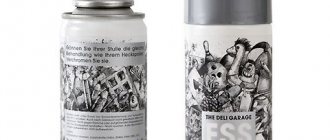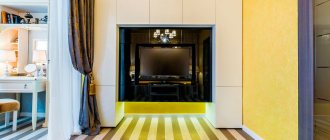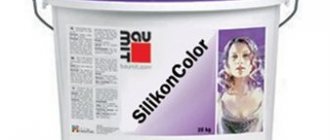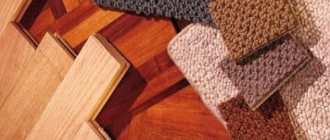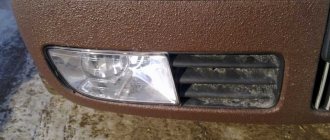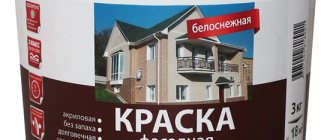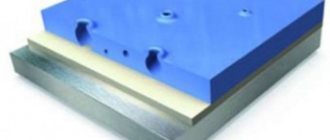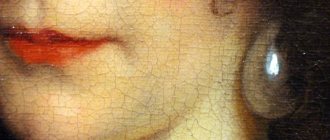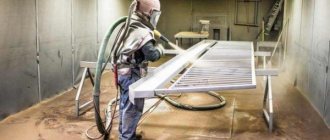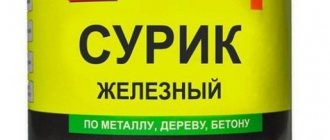Today, there is a large selection of anti-corrosion coatings for metal on the paint and varnish market. One of the most popular among them is zinc paint, which has many advantages.
Next we will look at what the features of this paint are, where and how it is used.
One type of anti-corrosion paint
Zinc coating Zinkator Verzinking
Zinc-rich paint is used for anti-corrosion protection of metal structures and equipment from rust.
Designed for operation in extreme conditions of an open atmosphere, it is also widely used indoors. The zinc-rich composition ZV Pu-Zinc is a primer layer in polyurethane and epoxy paint complexes. Including ZV Pu-Zinc is used as an independent coating that does not require painting with finishing materials.
Material description (PDF)
Polyurethane zinc material ZV Pu-Zinc resists industrial gases, mechanical stress, chemicals, intense abrasion, fresh and sea water. Zinkator Verzinking Pu-Zinc fully replaces hot-dip galvanizing and “works” under the most extreme operating conditions.
Purpose
Zinc-containing paint is most often used for painting ferrous metals that are used in difficult weather conditions. These compositions cover:
- building structures;
- bridge structures;
- ships;
- metal tanks;
- metal pipes;
- gas pipelines;
- agricultural machinery;
- metal pillars;
- tunnels;
- port facilities.
It is not prohibited to use paint with zinc in everyday life. It can be used to paint water pipes or heating radiators. If the paint functions as a primer, it is applied in 1-2 layers, and if as a coating - in 2-3.
Immunity to extreme temperatures
Special anti-corrosion additives stop rust and stop corrosion processes. Therefore, you are not required to prepare the surface to be painted in detail. Apply ZV Pu-Zinc directly to rust and old paint residue.
Zinkator Verzinking Pu-Zinc is a strong and versatile material for protecting metal from rust, acids, alkalis, salts and petroleum products.
Transportation and installation of structures and equipment can be carried out no earlier than 24 hours after painting, depending on the temperature regime of polycondensation of the coating.
Cold galvanizing method
It is not difficult to paint with paint containing zinc on your own, the main thing is to adhere to consistency in the process. Painting is no different from painting with conventional paints and consists of the following steps:
1. It is necessary to clean the surface of old finish, rust and other dirt. You can use regular sandpaper or a wire brush to complete this task. The coating must be clean after cleaning.
2. Prepare the coloring composition by stirring it thoroughly until a homogeneous structure is formed. If you need to thin the paint, you need to use a solvent, the type of which is indicated on its packaging.
3. The material is applied in a thin layer using a painting tool (brush, roller, spray gun). There is also paint on sale in aerosol form, which is applied evenly without forming smudges or streaks.
4. Re-application of the coloring composition is carried out after the previous layer has completely dried.
5. The final finishing process can be coating with decorative paint.
As a result of painting, the surface becomes 95% covered with zinc.
On video: preparing metal for galvanizing.
Feature of the ZV Pu-Zinc system
1. Application up to 98% humidity.
2. Drying time for ZV zinc paints to “touch” is 30 minutes.
3. Instant resistance to fresh and sea water.
4. Long service life of the zinc anti-corrosion “working” film.
5. Can be applied to an unprepared surface.
6. Extreme adhesive performance of ZV zinc paint.
7. Provides cathodic protection of the metal.
8. Our zinc paints are oil and grease resistant.
9. It is recommended to apply ZV zinc compounds at temperatures from -5°C to +50°C.
10. ZV is compatible with other polyurethane and epoxy compounds.
Peculiarities
Galvanizing extends the service life of the metal by 20-25 years. Galvanizing can be done using the usual hot method or electrochemical deposition only in industrial conditions. In this regard, painting with zinc paint is very popular and is called by craftsmen the “cold” galvanizing method.
Zinc-rich paint of any type and manufacturer contains zinc powder and binding components. It has its own characteristics: it creates double protection against corrosion processes, the resulting layer on the surface protects the metal from mechanical damage.
The advantages of zinc-containing paint for metal are:
- ease of application;
- the ability to paint over a separate damaged area or scratches;
- using a variety of application tools (brush, roller, spray);
- budget price of material;
- the ability to galvanize welding seams at the location of the structure;
- Galvanized products can be welded together;
- high degree of adhesion to almost all finishing materials;
- increasing the service life of metal products (the coating resists corrosion longer than others);
- Such paints are elastic, and therefore can withstand high temperatures and mechanical changes.
Processing metal using the “cold” galvanizing method is very easy to do with your own hands using ordinary painting tools. But the composition in an aerosol can will greatly simplify the task.
"Paint for galvanized metal"
Thanks to modern paints and varnishes, it is possible to extend the service life of metal products from 10 to 25 years, so any metal structures and equipment need protection from corrosion changes. Paint for galvanized metal can be used for painting roofs, private houses, factories, garages, hangars, warehouses, canopies, eaves, roofs and other products. Before painting galvanized surfaces, you should figure out why to do it and what is best for galvanized metal
Types of zinc paint
Protective agents against metal corrosion containing zinc are presented on the market in two versions, which differ in the binding components:
- with organic binders;
- with inorganic binders.
Zinc coatings with binders of organic origin are:
- epoxy;
- alkyd;
- urethane;
- chlorinated rubber.
Compositions with inorganic substances are presented in the form of silicate materials that contain zinc.
Coloring technology - step-by-step instructions
The general procedure for applying paint, as well as working conditions with the material, are indicated on the packaging with the composition. These recommendations must be taken into account when processing galvanized iron.
Preparatory work
Before painting, galvanized iron must be degreased using solvents and cleaned of contaminants. It is recommended to keep the material in the fresh air for 24 hours. In this case, the metal will absorb oxygen, which will have a positive effect on the adhesion of zinc.
Creating a protective layer
It is also recommended to treat the metal with an alkaline detergent before painting. The latter will remove remaining contaminants and create an additional protective layer.
Painting
The paint must be thoroughly stirred before use. If this is indicated in the instructions, then the appropriate solvent must be added to this composition. Painting is carried out using a brush or roller. If large surface areas are being treated, it is recommended to carry out the procedure using a sprayer. The number of layers that need to be applied to the metal is indicated in the instructions (minimum 2). To achieve a rich paint color, this procedure can be carried out 3 or more times.
Dyeing technology
Experts recommend painting galvanized steel a year after the start of use, when the oxidation products have completely disappeared and a durable patina film appears on the surface. Plus, during this time the coating will become slightly rough - the paint will stick much better. If painting is done immediately after purchase, it is advisable to pre-treat the surface of the sheets with abrasives.
To protect against corrosion during storage, manufacturers coat metal sheets with a layer of mineral oil. It must be dissolved with ammonia water. The old paint layer and traces of corrosion are cleaned off with fine abrasive sandpaper or a wire brush.
Be careful not to damage the coating. For large volumes, sandblasting is used. The surface must be clean and dry
This is especially true for alkyd enamel. If it gets exposed to dust or moisture, it will begin to peel off after drying. To degrease and remove salt stains, the metal is washed with a soap or alkaline solution and then dried well. Before coating with paints and varnishes, it is recommended to treat the surface with a primer. This will not only save paint, but also enhance adhesion. It is selected according to a color similar to the color of the paint and varnish composition. If necessary, solvents are introduced into it. Their types are always indicated in the manufacturer's instructions. Apply the paint in a thin layer using special sprayers. Small areas can be treated with a brush or roller. When applying subsequent layers, the surface should be thoroughly dried.
So, we have described in detail how to paint galvanized steel so that it does not peel off. For these purposes, special compounds with high adhesion are used that are resistant to aggressive environments and temperature changes. The industry offers a sufficient selection of colors of such paint and varnish compositions that have a long service life, from which you can choose the appropriate ones.
Types of aerosols
Conventionally, all aerosol coatings can be divided into three groups: nitro-enamel, alkyd and acrylic. Each variety has a universal composition that can be used when working with any surface.
Aerosol paints have less adhesion compared to conventional painting materials. However, this drawback does not matter when working with wood, since by their nature wood materials have a surface micro-relief, which contributes to better paint adhesion.
Acrylic sprays
This is the most common type of paint and varnish materials. It is used for exterior finishing and processing of interior parts. "Acrylics" have the following advantages:
- the speed of drying of the painted surface (for example, it will take no more than 20 minutes to completely dry one layer);
- possibility to choose a “finish”: matte, semi-matte, glossy;
- extensive color palette;
- ease of use;
- resistance to external factors (the coating is durable and not subject to fading).
In addition, unused spray paint lasts longer than an opened can of regular paint. This will allow you to use the already started aerosol at the moment when the need arises.
Alkyd-based aerosols
Alkyd compositions have the same advantages as acrylic sprays. However, there are differences between them. Due to their organic components, paints based on alkyd resins are highly toxic, so when working with such a composition, additional personal protective measures are required (respirator, special safety glasses).
The service life of an alkyd surface is significantly shorter than that of acrylic. This coating will have to be updated at least once a year.
Also, alkyd enamels have less adhesion due to their oil composition, so before painting the wood should be treated with a deep penetration primer.
But the choice of palette amazes with the variety of shades and halftones.
Nitrocellulose enamels
This type of paint and varnish material has the highest toxicity of all aerosol paints. This is due to the cellulose nitrate included in the composition. The use of a protective respirator is a necessary measure when working with such enamel. It is because of the toxic composition that nitro enamels are prohibited for use in some countries.
However, due to the release of a large amount of organic substances during drying, this composition reduces drying time and provides a glossy shine to the coating. Drying speed also affects paint application
Therefore, it is important to pre-treat the surface. Using a high-quality primer and applying it correctly will increase the adhesion of paint to wood and obtain a durable coating that is resistant to fading
Among the advantages of nitro enamels is their relatively low cost.
How to paint a surface
Let's get straight to work
If you plan to paint with aerosols yourself, you should pay attention to some rules of coloring technology. The surface must first be properly prepared:
Dust and dirt are removed from the surface. Then we further clean it by degreasing. White spirit is usually used.
The cleaned surface is primed. You can perform this process in the usual way, but it is better to use aerosol formulations.
It is better to use compositions for priming and painting from the same manufacturer. In this case, the possibility of incompatibility of the compositions is excluded.
Next, using masking tape, we protect those surfaces on which it is not desirable to get the paint composition. It is also necessary to prepare a rag to get rid of drips if necessary.
After all the preparatory work, we begin the painting process:
- To prepare the coloring composition for application to the surface, the can must be shaken several times.
- Then carry out a test painting on the test surface. If the result is satisfactory, we proceed to applying paint to the prepared surface.
- During the process, the position of the can should be such that the spray nozzle is directed at the surface to be painted at a distance of about 25 cm. The movements should be such that during painting the pigment is laid down in several layers, but do not overdo it. The layer thickness must be optimal to prevent drips.
- Aerosol painting should only be done in calm weather. It is best if the surface placement is horizontal. If the work is carried out on a vertical surface, then painting is carried out from top to bottom.
- After the initial painting is completed, let the paint dry for about 30 minutes. Next, apply the second layer. If desired, the last layer of paint is secured with aerosol varnish.
Metal paint usually takes 5 – 6 hours to dry. But it’s better if you give it about a day.
How to choose a composition?
Before deciding to purchase a specific composition for cold galvanizing, it is necessary to study its content and product quality. There is practically no possibility to choose by color; it is mostly a gray-matte shade. The material consumption does not differ much from the type of paint and the type of its application; on average, it amounts to 300 grams per square meter.
To choose a high-quality composition for galvanizing, you need to pay attention to the following:
- product cost;
- shelf life of the product;
- time for complete drying of 1 layer;
- amount of zinc in the composition;
- conditions under which the surface is processed;
- service life of the protective coating.
Cold galvanizing is a popular method among specialists for protecting metal products, which can be done at home with your own hands. With proper surface preparation, high-quality finishing materials and following the advice of the experts, metal galvanization will take place without problems.
Cold galvanizing technology with Galvanol composition (1 video)
Zinc-based paint of different brands (20 photos)
Popular Products
The construction market is replete with an assortment of compositions containing zinc, which are designed for cold galvanizing. The article is not enough to consider all the proposals, but you need to know about the most common zinc-containing paints.
The most famous compositions for cold galvanizing are:
- Galvanol. One of the most famous compositions, which is sold both in the form of a liquid solution and in the form of zinc paint spray. Great for indoor and outdoor use, temperature range from -30 to +50 degrees. The surface must first be prepared: cleaned, leveled and degreased.
- Cynotan. The solution is intended for cold galvanizing. Most often used as a surface primer. In areas of high pollution, it is recommended to paint surfaces with cynotane, regardless of weather conditions and climatic conditions. For more than a decade, Gazprom and the Russian Railways have been using this particular composition to galvanize their facilities.
- Cynotherm. This is an organosilicon solution that is used together with paint-and-varnish materials that contain melanin and perchlorovinyl.
- Zinkor. This is a zinc spray, which is recommended by experts for coating metal surfaces that require an increased degree of protection. Most often used for painting cars.
- Zinconol. This is a polyurethane based zinc primer intended for metal. A very commonly used product. Supplied both in metal buckets and in a spray can.
- CVES. This is a two-pack zinc ethyl silicate composition, a universal solution suitable for any type of metal.
How to buy Barrier-Zinc
- We work by cash and non-cash payments;
- We provide delivery;
- We ship to other cities by transport companies;
- Pickup from warehouses in Moscow, st. Promyshlennaya 11, gate 53, g. Moscow, Signalny proezd, 16 building 21, St. Petersburg, pos. Metallostroy, road to Metallostroy, 1, building 4, lit. A, Kazan, Tekhnicheskaya st., 9, Krasnodar, st. Topolinaya, 30, Ekaterinburg, st. Artinskaya, 22G, Tula, Khaninsky proezd, 6A, Nizhny Novgorod, Okskaya Gavan, 19k2
Prices are indicated in the price list.
For purchase or consultation, contact us by phone or email: [email protected]
How to paint galvanized iron: from choosing paint to painting
Over the years, it has been replaced by a more practical polymer coating, which is inferior in strength, corrosion resistance and durability only to powder coating. However, this process is very expensive and is performed in special heat chambers, so it has limited distribution. To combat small surface defects at home, a special polymer paint sold in cans will be useful. Most often - alkyd enamel for metal. The color match is selected using a special scale, which is universal and available from all sellers. Therefore, when purchasing corrugated sheeting, it is advisable to remember its number so that in the future you can easily know what paint to paint it with.
The restoration procedure is simple:
- the place is thoroughly cleaned;
- The can is shaken for about 1-2 minutes to average the composition;
- spraying is carried out from a distance of about 30 cm;
- after a short drying, you can apply the second and subsequent layers;
To cover the rusty area, it is recommended to choose paint with a rust converter.
Comparison of Tsinkoshov coating with other coatings
- home
- More about Tsinkoshov
- Comparison with other coatings
Tsinkoshov
is the first and unique composition for protecting welds, which has no analogues on the market. However, according to its characteristics, it is a powerful protection against metal corrosion, competing with other methods of protection. We will compare the qualities of Zinkoshov with other anti-corrosion coatings, as well as with the traditional hot-dip galvanizing method.
What are the methods of corrosion protection?
- Paints with anti-corrosion additives
based on alkyd, acrylic, epoxy or polyurethane create a coating that lasts 3-5 years. However, they are not able to provide complete protection against corrosion. Under the film of paint, corrosion can develop with might and main, destroying the metal. Even when the appearance of the coating remains unchanged. - Zinc-containing paints
fight corrosion more effectively due to the zinc in the composition, which corrodes more slowly than all metals. But simply containing zinc powder in paint is not capable of providing reliable protection against corrosion for 25-50 years. Only cold galvanizing compounds can do this.
In the photo: Salt fog chamber (test of protection duration). Test - 1200 hours 3% NaCl. On the left is zinc-containing paint, on the right is a composition for cold galvanizing (96% zinc).
Tsinkoshov is not only a special composition for protecting welds, but also a complete composition for cold galvanizing. Cold galvanizing can also be classified as coating materials. However, compared to other paints and enamels, they provide different levels of protection and provide coatings with different service life.
Conventional metal paints can last about 2 years without touch-ups, and cold galvanizing with Tsinkoshov can last up to 50 years.
The principle of operation of anti-corrosion paints
Oil- and alkyd-based paints create a weak barrier between metals and the environment, cannot withstand temperatures above 70-80 °C, quickly fade, peel, crack, and offer almost no protection against rust. Enamels based on acrylic, epoxy resin and water-based paints provide visual appeal and last 2-3 years without cracking under favorable operating conditions. They also do not withstand temperature changes, chemicals and mechanical damage. They protect against corrosion until the first crack in the coating, then environmental influences get under the film and the corrosion process starts.
The above types of enamels protect metals from above, and corrosion can develop under the paint film. Since the appearance remains attractive, you will not immediately notice the formation of rust and will not be able to quickly take the necessary measures to eliminate it.
How do zinc and aluminum paints work?
There are two types of zinc paints. These are zinc-containing paints, which contain from 10 to 85% zinc in the composition and zinc-rich compositions, where zinc is the main component and is contained in an amount of 95% or more. Only such compositions create a galvanizing effect that can protect metals for several decades. Tsinkoshov is just such a composition for cold galvanizing.
Zinc-containing paints can protect metals from corrosion for a period of 10 years. This opportunity is given to them by zinc, which, according to studies, corrodes 3 times slower than other metals. That is, 1 zinc layer on top of another metal will slow down corrosion as much as possible for about 10 years, depending on operating conditions.
The zinc-rich composition of Tsinkoshov is characterized by a high zinc content of 96%. In addition, the zinc in the dry coating film is 98-99.99% pure. In addition, the composition contains a special polymer binder and neutral resins, which allow zinc to freely move electrons and actively act in the fight against corrosion. Only such anti-corrosion paints can protect metals from corrosion in the same way as with the “hot” galvanizing method. That's why they are called cold galvanizing.
Aluminum is also a slowly corroding metal that is used to protect metals from corrosion. In addition to protection, it gives metals an attractive silver color and shine. The Alyumoshov coating contains aluminum powder and protects metals from corrosion for up to 10 years. However, without primer, such a coating will last only 2-3 years. It is recommended to use Alyumoshov as a topcoat for Tsinkoshov. Then the protection period will increase by an additional 10 years to the declared service life of Tsinkoshov. The aluminum coating will additionally protect the metal from corrosion, and will also protect the zinc coating from environmental influences: moisture, air, sea and fresh water, chemicals, oil products and other things.
How does Tsinkoshov protect from 10 to 50 years?
This is achieved through tread protection. Enamels without zinc do not have such protection and are protected only by the barrier method. Tsinkoshov, in contrast, protects in two ways at once: barrier and protector. The tread method is also called active or cathodic.
Sacrificial protection means that zinc protects the metal it coats and donates its electrons to it to fight corrosion. Zinc acts actively, even if the integrity of the coating has been damaged, in case of scratches and mechanical damage to the layer. Corrosion does not reach the metal surface until the entire zinc layer is depleted. Therefore, such protection is called active.
Comparison of Tsinkoshov and conventional paint
| Indicators | Tsinkoshov (cold galvanizing) | Regular metal paint (alkyd) |
| Drying time | 20 minutes | 24 hours |
| Life time | From 10 years (1 layer) | Maximum 2-3 years |
| Corrosion protection | Completely prevents corrosion for the stated period | Slows down corrosion, hides hot spots under film |
| Base for painting | No soil needed | Need soil |
| Color | Gray matte | According to the RAL catalog |
| Number of layers | 1 layer is enough | 2-3 layers |
How long does Zinkoshov coating protect?
Calculation of the cost of covering Tsinkoshov
Comparison of Zinkoshov and hot-dip galvanizing
We have already seen that LKM is inferior compared to Tsinkoshov in many respects. However, this composition also has advantages compared to the traditional, popular method of protecting metals from corrosion - hot galvanizing. If we compare the two methods, we get the following data:
| Cold galvanizing (Tsinkoshov) | Hot galvanizing |
| Advantages | |
| — Dries in 20 minutes — Compatible with almost any paintwork — Regular solvent is suitable — Protective properties are higher with equal coating thickness — Corrosion cannot form under the coating — Protects seams after welding — Welding after application is allowed — Structures do not need to be transported — no transportation costs — Adhesion – 1 point – Does not rust in areas of damage – Easy to restore damaged areas – Can be applied locally, to small areas, seams and joints | — Small products are dipped easily and quickly — 100% penetration into hard-to-reach places — The price is calculated based on the weight of the structure — The quality of the coating does not depend on who is applying it — Forms a continuous coating, without joints or boundaries — Gives metals visual appeal — Everything will be done for you specialists - less of your time and effort |
| Flaws | |
| — Strict adherence to the technological process — It is difficult to coat internal cavities and hard-to-reach places — Careful surface preparation is required | — Dipping baths are limited in size - not suitable for very large structures — Does not work with some grades of metals — Deformation of thin structures when heated — Welding parts after hot-dip galvanizing destroys the protection — Damaged coating cannot be repaired, only galvanize the entire structure again — For dipping and hanging to the structure, special “ears” are welded, from which traces then remain - When assembling the structure after galvanizing, the joints and assembly points must be additionally protected from corrosion - It is necessary to bring the structures to the place of galvanizing and back - additional transportation costs - During transportation, areas destroyed which then need additional protection - After galvanizing, unsightly streaks of “liquid” zinc may remain |
Based on the above, we can see that traditional and proven methods of galvanizing, such as hot galvanizing, although they have been used for decades, still have a lot of disadvantages compared to modern methods.
Cold galvanizing using the Zinkoshov composition is conveniently and quickly applied to small areas, seams and joints anywhere in the structure, for example, right at the site of its operation. You don’t need to transport anything anywhere and can be used for structures and seams of any size and complexity.
For clarity, we present you with a comparative table of different methods of corrosion protection and their advantages.
Pros and cons of galvanizing methods (in comparison with Tsinkoshov)
| Characteristics | Cold galvanizing (Tsinkoshov) | Hot galvanizing | Dye |
| Active cathodic protection | + | + | — |
| Easy on-site application | + | — | + |
| Repeated application | + | + | — |
| Finish coating possible | + | +/- | + |
| Application under extreme conditions (high humidity and low temperature) | + | — | — |
| Unlimited shelf life | + | — | — |
| Contact with drinking water | + | + | — |
| Temperature and mechanical stability | + | — | — |
| Welding on coating | + | +/- | — |
| Coating restoration | + | — | — |
| Application at negative temperatures (-35) | + | — | — |
CONTACT US RIGHT NOW AND GET 5% DISCOUNT ON YOUR FIRST PURCHASE
Telephone:
Email:
[email protected]
